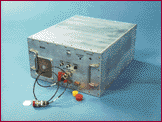



Objectives
The objective of this experiment was to determine the effects of microgravity and space flight on the electrical and magnetic properties of high-temperature superconductivity materials (HTS).
Shuttle-Mir Missions Approach Results Earth Benefits Publications Principal Investigators![]()
NASA-3
MIDAS was launched on STS-79 and transferred to the Mir Space Station. It stayed on the Mir for the NASA-3 mission and brought back to the ground on STS-81. Twenty-four superconductive specimens were tested as part of the MIDAS experiment; 12 were produced by Langley Research Center, 6 were provided by the Moscow Institute of Electronic Equipment in conjuction with the Russian Space Center - Energia, and 6 were provided by the Eaton Corporation of Milwaukee, Wisconsin. Superconductive specimens were embedded into a hybrid measurement circuit board that was located in a self-contained payload. Electrical properties were recorded by a data acquistion and storage system capable of performing direct current four-probe resistance measurements and storing the acquired data. The aim of MIDAS was to measure the critical transition temperature and critical current density of these specimens during superconductive conditions (75K) in microgravity.
The MIDAS research results show that superconductive thick films can be successfully produced, integrated into durable electronic packages, and operated in a microgravity environment. While aboard the Mir, the specimens exhibited electrical properties that approximate those observed on the ground. Furthermore, the data show that the critical transition temperature (Tc) and critical current density (Jc) properties did not degrade over time while in space, as evidenced by both the on-orbit and postflight data. Finally, the electrical resistance and current versus voltage characteristics of the thick film specimens when taken at temperatures above the Tc showed no change during the 90 days of measurements on orbit. These findings demonstrate the survivability of the superconductive films and serve to relieve some of the concerns associated with the incorporation of these new materials into space systems.
Knowledge gained from the MIDAS technology could lead to advances in cryogenic refrigeration systems, which would benefit the medical industry, communications technology, and energy transmission and storage systems. Additionally, this technology may enhance the production of high temperature superconductive electronics and high-speed computing devices.
None available at this time.
Stephanie Wise
NASA/Langley Research Center
![]()
|
|
Curator:
Julie Oliveaux
Responsible NASA Official: John Uri |
Page last updated: 07/16/1999
.gif)